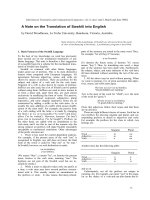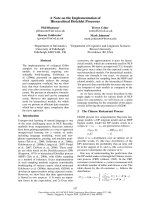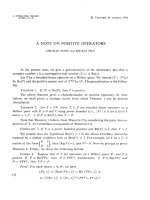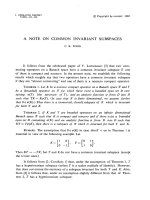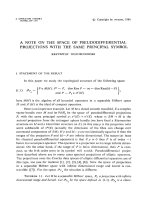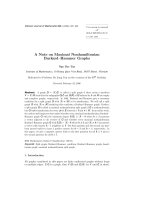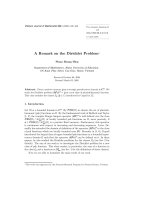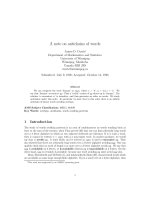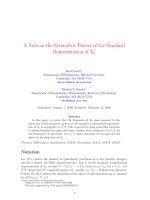Báo cáo toán học: "A Note on The Rogers-Fine Identity" pot
Bạn đang xem bản rút gọn của tài liệu. Xem và tải ngay bản đầy đủ của tài liệu tại đây (87.64 KB, 5 trang )
A Note on The Rogers-Fine Identity
Jian-Ping Fang
∗
Department of Mathematics, Huaiyin Teachers College, Huaian, Jiangsu 223300, P. R. China
Department of Mathematics, East China Normal University, Shanghai 200062, P. R. China
Submitted: May 29, 2006; Accepted: Jul 30, 2007; Published: Aug 9, 2007
Mathematics Subject Classifications: 05A30; 33D15; 33D60; 33D05
Abstract
In this paper, we derive an interesting identity from the Rogers-Fine identity by
applying the q-exponential operator method.
1 Introduction and main result
Following Gasper and Rahman [7], we write
(a; q)
0
= 1, (a; q)
n
= (1 − a)(1 − aq) ···(1 − aq
n−1
), n = 1, ···, ∞,
r
Φ
s
a
1
, ···, a
r
b
1
, ···, b
s
;
q, x
=
∞
n=0
(a
1
, a
2
, ···, a
r
; q)
n
(q, b
1
, ···, b
s
; q)
n
(−1)
n
q
n(n−1)/2
1+s−r
x
n
.
For convenience, we take |q| < 1 in this paper.
Recall that the Rogers-Fine identity [1, 2, 6, 10] is expressed as follows:
∞
n=0
(α; q)
n
(β; q)
n
τ
n
=
∞
n=0
(α; q)
n
(qατ/β; q)
n
(1 − ατq
2n
)
(β; q)
n
(τ; q)
n+1
(βτ)
n
q
n
2
−n
. (1)
This identity (1) is one of the fundamental formulas in the theory of the basic hyper-
geometric series. In this paper, we derive an interesting identity from (1) by applying the
q-exponential operator method. As application, we give an extension of the terminating
very-well-poised
6
Φ
5
summation formula. The main result of this paper is:
∗
Jian-Ping Fang supported by Doctorial Program of ME of China 20060269011.
the electronic journal of combinatorics 14 (2007), #N17 1
Theorem 1.1. Let a
−1
, a
0
, a
1
, a
2
, ···, a
2t+2
be complex numbers, |a
2i
| < 1 with i =
0, 1, 2, ···, t + 1, then for any non-negative integer M, we have
M
n=0
(q
−M
, c, a
2
, a
4
, ···, a
2t+2
; q)
n
(β, b, a
1
, a
3
, ···, a
2t+1
; q)
n
τ
n
=
M
m=0
(q
−M
; q)
m
(τq
1−M
/β; q)
m
(1 − τq
2m−M
)
(β; q)
m
(τ; q)
m+1
(βτ)
m
q
m
2
−m
×
t+1
j=0
(a
2j
; q)
m
(a
2j−1
; q)
m
m
m
1
=0
(q
−m
, q
1−m
/β, b/c; q)
m
1
(q, q
1−M
τ/β, q
1−m
/c; q)
m
1
0≤m
t+2
≤m
t+1
≤···≤m
2
≤m
1
t+1
i=1
(q
−m
i
, q
1−m
/a
2i−3
, a
2i−1
/a
2i
; q)
m
i+1
(q, q
1−m
/a
2i
, q
1−m
i
a
2i−2
/a
2i−3
; q)
m
i+1
q
m
1
+m
2
+···+m
t+2
, (2)
where t = −1, 0, 1, 2, ···, ∞, c = a
0
and b = a
−1
.
2 The proof of the theorem and its application
Before our proof, let’s first make some preparations. The q-differential operator D
q
and q-shifted operator η (see [3, 4, 8, 9]), acting on the variable a, are defined by:
D
q
{f(a)} =
f(a) − f (aq)
a
and η {f(a)} = f(aq).
Rogers [9] first used them to construct the following q-operator
E(dθ) = (−dθ; q)
∞
=
∞
n=0
q
(n−1)n/2
(dθ)
n
(q; q)
n
, (3)
where θ = η
−1
D
q
. Note that, Rogers used the symbol qδ to denote θ [9]. Then he
applied it to derive relationships between special functions involving certain fundamental
q-symmetric polynomials. This operator theory was developed by Chen and Liu [4] and
Liu [8]. They employed (3) to obtain many classical q-series formulas. Later Bowman
[3] studied further results of this operator and gave convergence criteria. He used it to
obtain results involving q-symmetric expansions and q-orthogonal polynomials. Inspired
by their work, we constructed the following q-exponential operator [5]
Definition 2.1. Let θ = η
−1
D
q
, b, c are complex numbers. We define
1
Φ
0
b
−
;
q, −cθ
=
∞
n=0
(b; q)
n
(−cθ)
n
(q; q)
n
. (4)
In [5], we have applied it to obtain some formal extensions of q-series formulas. Notice
that the operator E(dθ) follows (4) by setting c = dh, b = 1/h, and taking h = 0. The
following operator identities were given in [5]:
the electronic journal of combinatorics 14 (2007), #N17 2
Lemma 2.1. If s/ω = q
−N
, |cst/ω| < 1, where N is a non-negative integer, then
1
Φ
0
b
−
;
q, −cθ
(as, at; q)
∞
(aω; q)
∞
=
(as, at, bct; q)
∞
(aω, ct; q)
∞
3
Φ
2
b, s/ω, q/at
q/ct, q/aω
;
q, q
. (5)
Lemma 2.2. For |cs| < 1,
1
Φ
0
b
−
;
q, −cθ
{(as; q)
∞
} =
(as, bcs; q)
∞
(cs; q)
∞
. (6)
Now let’s return to the proof of Theorem 1.1. Employing
(q/a; q)
n
= (−a)
−n
q
n(n+1)/2
(q
−n
a; q)
∞
(a; q)
∞
, (7)
and setting α = q
−M
in (1), we rewrite the new expression as follows:
M
n=0
q
−M
; q
n
(βq
n
; q)
∞
τ
n
=
M
n=0
(q
−M
; q)
n
(1 − q
2n−M
τ)
(τ; q)
n+1
−q
−M
τ
2
n
×q
n(3n−1)/2
(βq
M−n
/τ, βq
n
; q)
∞
(βq
M
/τ; q)
∞
. (8)
Applying the operator
1
Φ
0
b
−
;
q, −cθ
to both sides of (8) with respect to the
variable β then we have
M
n=0
q
−M
; q
n
τ
n
1
Φ
0
b
−
;
q, −cθ
{(βq
n
; q)
∞
}
=
M
n=0
(q
−M
; q)
n
(1 − τq
2n−M
)
(τ; q)
n+1
−q
−M
τ
2
n
× q
n(3n−1)/2
1
Φ
0
b
−
;
q, −cθ
(βq
M−n
/τ, βq
n
; q)
∞
(q
M
β/τ; q)
∞
.
By (5) and (6), we have the relation
M
n=0
(q
−M
, c; q)
n
(β, bc; q)
n
τ
n
=
M
n=0
(q
−M
; q)
n
(q
1−M
τ/β, c; q)
n
(1 − τq
2n−M
)
(β, bc; q)
n
(τ; q)
n+1
(βτ)
n
q
n
2
−n
×
3
Φ
2
q
−n
, b, q
1−n
/β
q
1−M
τ/β, q
1−n
/c
;
q, q
. (9)
the electronic journal of combinatorics 14 (2007), #N17 3
Using (7) again , we rewrite (9) as follows:
M
n=0
(q
−M
, c; q)
n
(β; q)
n
τ
n
(bcq
n
; q)
∞
=
M
n=0
(q
−M
; q)
n
(q
1−M
τ/β, c; q)
n
(1 − τq
2n−M
)
(β; q)
n
(τ; q)
n+1
(βτ)
n
q
n
2
−n
×
n
n
1
=0
(q
−n
, q
1−n
/β; q)
n
1
q
n
1
(q, q
1−M
τ/β, q
1−n
/c; q)
n
1
(b, bcq
n
; q)
∞
(bq
n
1
; q)
∞
. (10)
Applying the operator
1
Φ
0
a
1
−
;
q, −a
2
θ
to both sides of (10) with respect to the
variable b, from (5) and (6) and simplifying then we have
M
n=0
(q
−M
, c, a
2
c; q)
n
(β, bc, a
1
a
2
c; q)
n
τ
n
=
M
n=0
(q
−M
; q)
n
(q
1−M
τ/β, c, a
2
c; q)
n
(1 − τq
2n−M
)
(β, bc, a
1
a
2
c; q)
n
(τ; q)
n+1
(βτ)
n
q
n
2
−n
×
n
n
1
=0
(q
−n
, q
1−n
/β, b; q)
n
1
(q, q
1−M
τ/β, q
1−n
/c; q)
n
1
q
n
1
n
1
n
2
=0
(q
−n
1
, q
1−n
/bc, a
1
; q)
n
2
(q, q
1−n
/a
2
c, q
1−n
1
/b; q)
n
2
q
n
2
. (11)
Replacing bc by b in (9), we have the case of t = −1. If we replace (bc, a
2
c, a
1
a
2
c) by
(b, a
2
, a
1
) in (11) respectively, we obtain the case of t = 0.
By induction, similar proof can be performed to get the equation (2).
Letting t = −1 in (2), and then setting b = q
1−M
τ/β, we have the following identity:
Corollary 2.1. If |c| < 1, then
M
n=0
(q
−M
, c; q)
n
(β, q
1−M
cτ/β; q)
n
τ
n
=
M
n=0
(q
−M
; q)
n
(q
1−M
τ/β, β/c; q)
n
(1 − τq
2n−M
)
(β, q
1−M
cτ/β; q)
n
(τ; q)
n+1
(−cτ)
n
q
n(n−1)/2
. (12)
Combined with (12), we can get the following extension of the terminating very-well-
poised
6
Φ
5
summation formula:
Theorem 2.1. For |c| < 1, |e| < 1 and |τ| < 1
M
n=0
(1 − τq
2n
)(τ, q
−M
; q)
n
(1 − τ)(q, τq
M+1
; q)
n
(−cτq
M
)
n
q
n(n−1)
2
(q/c, eτ ; q)
n
(cτ, deτ; q)
n
×
3
Φ
2
q
−n
, q
1−n
/cτ, d
q
1−n
/eτ, q/c
;
q, q
=
(τq, eτ; q)
M
(cτ, deτ; q)
M
. (13)
Proof. Setting β = q and replacing τ by τq
M
in (12), we have
(τq; q)
M
(cτ; q)
M
=
M
n=0
(1 − τq
2n
)(τ, q/c, q
−M
; q)
n
(1 − τ)(q, cτ, τq
M+1
; q)
n
(−cτq
M
)
n
q
n(n−1)/2
. (14)
the electronic journal of combinatorics 14 (2007), #N17 4
Employing (7), we rewrite (14) as follows:
(τq; q)
M
(cτq
M
; q)
∞
=
M
n=0
(1 − τq
2n
)(τ, q
−M
; q)
n
(1 − τ)(q, τq
M+1
; q)
n
(τq
M
)
n
q
n
2
(cq
−n
, cτq
n
; q)
∞
(c; q)
∞
. (15)
Applying the operator
1
Φ
0
d
−
;
q, −eθ
to both sides of (15) with respect to the
variable c, using (5) and (6) and simplifying then we complete the proof.
Taking d = q/c then setting e = cf/q in (13), we have
Corollary 2.2 (The terminating very-well-poised
6
Φ
5
summation formula).
6
Φ
5
q
−M
, τ, q
√
τ, −q
√
τ, q/c, q/f
τq
M+1
,
√
τ, −
√
τ, cτ, fτ
;
q, cf τq
M−1
=
(τq, cfτ/q; q)
M
(cτ, fτ; q)
M
.
Remark: In the context of this paper, convergence of the basic hypergeometric series
is no issue at all because they are terminating q-series.
Acknowledgements: I would like to thank the referees for their many valuable
comments and suggestions. And I am grateful to professor D. Bowman who presented me
some information about reference [3].
References
[1] G. E. Andrews, A Fine Dream, Int. J. Number Theory, In Press, 2006.
[2] B. C. Berndt, Ae Ja Yee, Combinatorial Proofs of Identities in Ramanujan’s Lost
Notebook Associated with the Rogers-Fine Identity and False Theta Functions, Ann.
Comb., 7 (2003), 409–423.
[3] D. Bowman, q−Differential Operators, Orthogonal Polynomials, and Symmetric Ex-
pansions, Mem. Amer. Math. Soc., 159 (2002).
[4] W. Y. C. Chen, Z G. Liu, Parameter Augmentation For Basic Hypergeometric Series
I, In: B. E. Sagan, R. P. Stanley (Eds.), Mathematical Essays in Honor of Gian-
Carlo Rota, Progr. Math., 161 (1998), 111–129.
[5] J P. Fang, q−Differential operator identities and applications, J. Math. Anal. Appl.,
332 (2007), 1393–1407.
[6] N. J. Fine, Basic Hypergeometric Series and Applications, American Mathematical
Society, Providence, RI, 1988.
[7] G. Gasper, M. Rahman, Basic Hypergeometric Series, Cambridge University Press,
Cambridge, Ma, 1990.
[8] Z G. Liu, Some Operator Identities and q-Series Transformation Formulas, Discrete
Math., 265 (2003), 119–139.
[9] L. J. Rogers, On the expansion of some infinite products, Proc. London Math.Soc.,
24 (1893), 337–352.
[10] L. J. Rogers, On two theorems of combinatory analysis and some allied identities,
Proc. London Math.Soc., 16 (1917), 315–336.
the electronic journal of combinatorics 14 (2007), #N17 5
